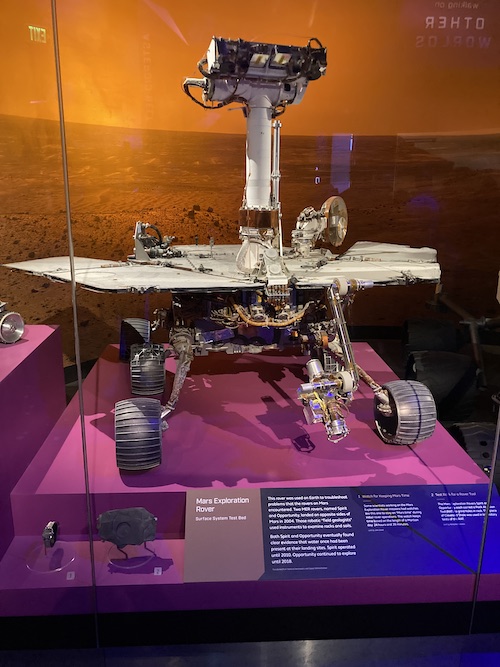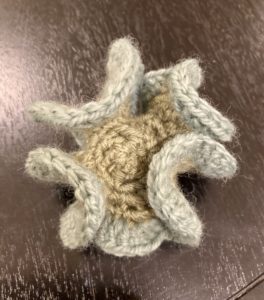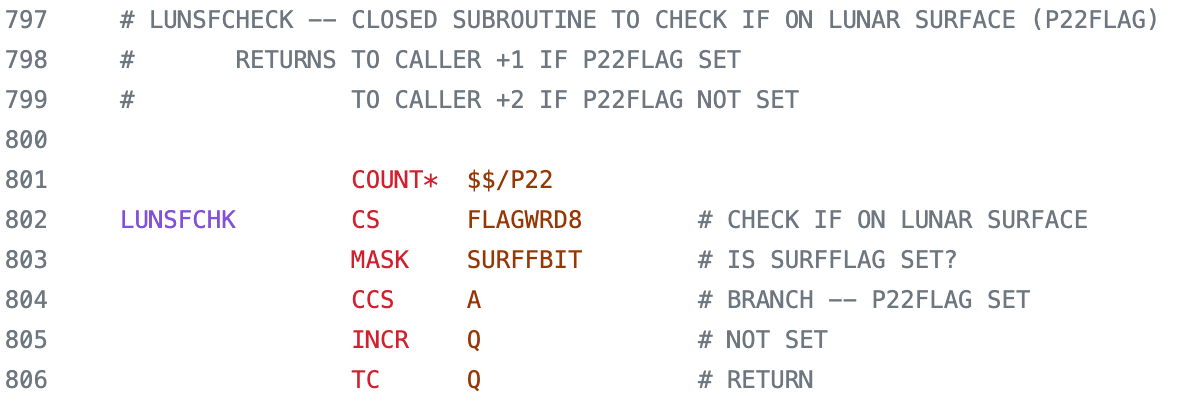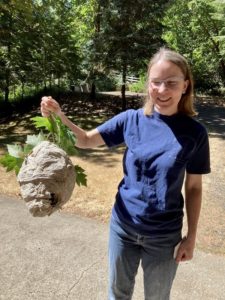January 26th, 2024 at 4:51 pm (Spacecraft, Travel)
Recently I visited the Smithsonian Air and Space Museum on the Mall for the first time. I lost myself in the aviation section for a couple of hours, learning all sorts of interesting things about the history of our airlines, flight attendants, airmail, aircraft development, and even a board game for instrument flying!
Then I went into the exhibit dedicated to our planets and was immediately drawn to the Mars section. It featured three examples of our Mars rover lineage, increasing in size from Sojourner to the Mars Exploration Rovers to the Mars Science Laboratory rover.

“Huh,” I thought, “They didn’t bother to mock up solar panels for the Mars Exploration Rover.”
I stared at its blank grey deck for a few more seconds before I remembered where else I’d seen a Mars Exploration Rover with no solar panels: at JPL, where I worked on the planning team for the Mars Exploration Rover Opportunity. While Opportunity was at Mars, we had a twin rover here on Earth in the Mars Yard (or the In-Situ Instrument Laboratory) where we could try out command sequences before sending them to Mars. That rover, too, did not have solar panels because it was powered by a cable that plugged into the wall.
I squinted more closely at the display and found that it identified this object as the “Surface System Test Bed” (SSTB) which meant that IT IS EXACTLY THE TEST ROVER that we used at JPL during mission operations. Confirmed: in 2019, which was after both Mars Exploration Rover missions had ended, the MER SSTB was sent to the Smithsonian.
And what better place, really, for such a unique artifact? Even if it totally took me by surprise. I think the other museum-goers were surely puzzled by the sight of a woman standing in front of the Mars rovers and crying.
1 Comments
0 of 1 people learned something from this entry.
November 12th, 2023 at 7:53 am (Knitting, Mathematics)
You never know what you’ll learn at the library!
Recently, the Corvallis-Benton County Public Library began hosting a monthly Fiber Arts Meetup, which is culminating next weekend (Nov. 18) with a Coral Reef Community Art Collaboration. Although there are many kinds of relevant crafts and projects, one that was featured was hyperbolic crochet. Rather than being an exaggerated form of crochet, this is the process of creating “negatively curved” surfaces. This is a word for a surface that curves in two directions away from what is “flat” (tangent), like a saddle (bending down on your left and right, and up in the front and back). A positively curved surface bends only in one direction, like when you’re on top of a mountain looking down on all sides. A surface with zero curvature would be infinitely flat in all directions.
You can play with this in crochet. If you crochet a doily or a potholder, that generally would have zero curvature. But if you wedge in extra stitches so that they simply cannot lie flat, you’re going to generate a curved surface. The method I learned for hyperbolic crochet simply has you doubling the number of stitches in each hole as you go around, an exponential growth that creates a very organic-looking ruffled structure:

And because yarn (and knitting) is flexible, the same shape can shift into another 3D configuration where the negative curvature is even more evident:

It is surprisingly fun to play with this object and feel how it moves and shifts. What you can’t do is make it lie flat, at least in our three-dimensional world. Each row has twice as much length within it as the previous one. Such a fascinating construction! Thank you, Mari Beth, for teaching me!
1 Comments
September 23rd, 2023 at 7:37 am (Medicine)
Recently I learned that we can actually grow miniature human organs in a tiny, nutrient-rich environment and keep them alive. This has all sorts of useful applications such as testing the safety of new drugs here on Earth or assessing the impact of radiation on human tissues in space. In fact, the tissues can even be grown from a particular person’s stem cells and then multiple tiny organs connected together so that systemic effects can also be studied. Apparently while I wasn’t looking, this bit of science fiction became reality!

 A few days later, I had a thoroughly unexpected moment of convergence. I was visiting the Evergreen Air and Space Museum and marveling at, among other things, their full size model of the Spirit of St. Louis. While reading the poster about Charles Lindbergh, I learned that among his many interests and activities, in 1935 he also invented a perfusion pump – a device meant to keep organs alive outside the human body by artificially circulating oxygen and nutrients (and keeping out infection). (The picture at right is credited to Georgetown University.) I’m sure he’d be thrilled to see the latest advances, less than a hundred years later.
A few days later, I had a thoroughly unexpected moment of convergence. I was visiting the Evergreen Air and Space Museum and marveling at, among other things, their full size model of the Spirit of St. Louis. While reading the poster about Charles Lindbergh, I learned that among his many interests and activities, in 1935 he also invented a perfusion pump – a device meant to keep organs alive outside the human body by artificially circulating oxygen and nutrients (and keeping out infection). (The picture at right is credited to Georgetown University.) I’m sure he’d be thrilled to see the latest advances, less than a hundred years later.
A curious mind can be applied to solve all sorts of problems!
Comments
August 17th, 2023 at 10:24 pm (Computers, History)
 This iconic image shows Margaret Hamilton standing next to a printout of the flight software that she and her team wrote to control the Apollo Guidance Computer. I recently discovered that the code has been made available via a scan of the printouts, later re-typed as code, and uploaded to GitHub. The code is written in assembly, which consists of individual instructions to load, calculate, and act on data values. Today we use compilers so we can write code in higher-level languages that are easily understandable by humans, but at the time compilers were still pretty new, and the available memory was so limited that they wanted humans to do the optimization at the individual instruction level. Wow!
This iconic image shows Margaret Hamilton standing next to a printout of the flight software that she and her team wrote to control the Apollo Guidance Computer. I recently discovered that the code has been made available via a scan of the printouts, later re-typed as code, and uploaded to GitHub. The code is written in assembly, which consists of individual instructions to load, calculate, and act on data values. Today we use compilers so we can write code in higher-level languages that are easily understandable by humans, but at the time compilers were still pretty new, and the available memory was so limited that they wanted humans to do the optimization at the individual instruction level. Wow!
Here’s an example excerpt from the code. Even if you don’t know AGC assembly (I don’t), it’s possible to follow along due to the excellent comments.

I’m in awe of how this massive software engineering project would have proceeded (How did they test it? And without modern version control… did they use periodic printouts in case they found a mistake and wanted to roll back?) What an inspiring project!
Browsing the open issues on the project, they seem dedicated to increasing the quality of the content by carefully proofreading it against the original scans of the code printouts. What a labor of love :) But what a wonderful piece of programming history!
Comments
August 10th, 2023 at 6:04 pm (Animals)
The other day, I discovered an enormous wasp nest (about 14″ in diameter) in a tree next to my house:
The next morning, Google helped me discover Dan Scollard, who comes out to remove wasps from homes, humanely “sends them to sleep” in a cooler full of dry ice, then donates them to a lab that extracts the venom for use in allergy shots. (!)
When he arrived, he said, “Oh, that’s a beauty. A lot of people say they found a nest as big as a basketball, but yours actually IS.”
My nest was constructed and occupied by the bald-faced hornet (which apparently is actually a wasp). Dan told me all about this wasp; he has a real admiration for them. I highly recommend reading about their life cycle and also viewing Dan’s photo gallery! These wasps are a useful part of nature, but risky to have next to your door where you (or unwitting visitors) could be suddenly attacked. Apparently this wasp can be quite aggressive and territorial.
Dan put on all of his gear, then vacuumed up all of the wasps around the nest, waited a bit for more wasps to come home from hunting, did a second vacuuming pass, and clipped the nest from the branch to remove it. He said it would hang it in his backyard so the queen (who had not emerged) could “live out the rest of her days in peace.” He said I could hold the nest with its lurking queen: gosh wow!

What an amazing experience! It’s a joy to meet knowledgeable people who love their subject and use their knowledge to do good in the world. I’m much happier sending these wasps out to help people avoid severe reactions, and the process was so much better than dousing the nest with poison. Thank you, Dan!
1 Comments
1 of 1 people learned something from this entry.






